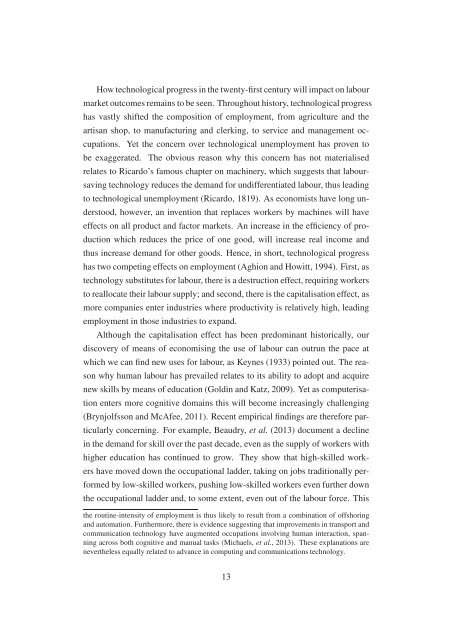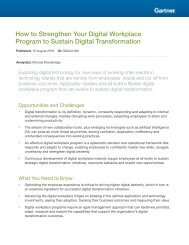The_Future_of_Employment
Create successful ePaper yourself
Turn your PDF publications into a flip-book with our unique Google optimized e-Paper software.
How technological progress in the twenty-first century will impact on labour<br />
market outcomes remains to be seen. Throughout history, technological progress<br />
has vastly shifted the composition <strong>of</strong> employment, from agriculture and the<br />
artisan shop, to manufacturing and clerking, to service and management occupations.<br />
Yet the concern over technological unemployment has proven to<br />
be exaggerated. <strong>The</strong> obvious reason why this concern has not materialised<br />
relates to Ricardo’s famous chapter on machinery, which suggests that laboursaving<br />
technology reduces the demand for undifferentiated labour, thus leading<br />
to technological unemployment (Ricardo, 1819). As economists have long understood,<br />
however, an invention that replaces workers by machines will have<br />
effects on all product and factor markets. An increase in the efficiency <strong>of</strong> production<br />
which reduces the price <strong>of</strong> one good, will increase real income and<br />
thus increase demand for other goods. Hence, in short, technological progress<br />
has two competing effects on employment (Aghion and Howitt, 1994). First, as<br />
technology substitutes for labour, there is a destruction effect, requiring workers<br />
to reallocate their labour supply; and second, there is the capitalisation effect, as<br />
more companies enter industries where productivity is relatively high, leading<br />
employment in those industries to expand.<br />
Although the capitalisation effect has been predominant historically, our<br />
discovery <strong>of</strong> means <strong>of</strong> economising the use <strong>of</strong> labour can outrun the pace at<br />
which we can find new uses for labour, as Keynes (1933) pointed out. <strong>The</strong> reason<br />
why human labour has prevailed relates to its ability to adopt and acquire<br />
new skills by means <strong>of</strong> education (Goldin and Katz, 2009). Yet as computerisation<br />
enters more cognitive domains this will become increasingly challenging<br />
(Brynjolfsson and McAfee, 2011). Recent empirical findings are therefore particularly<br />
concerning. For example, Beaudry, et al. (2013) document a decline<br />
in the demand for skill over the past decade, even as the supply <strong>of</strong> workers with<br />
higher education has continued to grow. <strong>The</strong>y show that high-skilled workers<br />
have moved down the occupational ladder, taking on jobs traditionally performed<br />
by low-skilled workers, pushing low-skilled workers even further down<br />
the occupational ladder and, to some extent, even out <strong>of</strong> the labour force. This<br />
the routine-intensity <strong>of</strong> employment is thus likely to result from a combination <strong>of</strong> <strong>of</strong>fshoring<br />
and automation. Furthermore, there is evidence suggesting that improvements in transport and<br />
communication technology have augmented occupations involving human interaction, spanning<br />
across both cognitive and manual tasks (Michaels, et al., 2013). <strong>The</strong>se explanations are<br />
nevertheless equally related to advance in computing and communications technology.<br />
13





